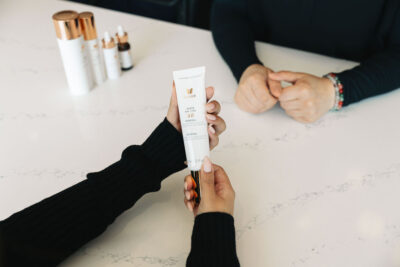August 4, 2022
What is Vitiligo?
Vitiligo is an autoimmune skin condition that prevents normal pigmentation of the skin, leading instead to the appearance of ‘white patches’ of skin. The underlying cause or trigger associated with this condition is not known at present. Vitiligo can affect people of any age, and can affect any areas of the skin, hair and even the mucous membranes (genital area and mouth). Unfortunately, individuals with this condition can often experience low self-esteem, depression, and a lack of confidence. It is especially true for those with these patches on large exposed areas of their body or having a greater contrast between the white patches and their normal skin color. Unfortunately, it isn’t possible to predict with certainty where, or if vitiligo will appear in individuals. However, once the patches appear, treatment should be initiated as soon as possible.
Treating Vitiligo
Treatment options for vitiligo often range from topical treatments (steroid and non-steroid options), camouflage and depigmenting creams, phototherapy and even systemic therapy options. An appropriate sunscreen should always be worn and reapplied, as those with this condition are at higher risk of developing skin cancer in the affected areas. A Dermatologist will be able to help you determine the most appropriate treatment option(s) after an initial assessment of your condition.
Topical steroids and non-steroid prescription medications are often used in cases of limited involvement, where the white patches are relatively confined to a smaller body surface area. While repigmentation may be seen in the treated areas with these therapies, prolonged use of topical steroids can potentially lead to skin atrophy (thinning) and stretch marks in the areas of application.
Phototherapy is also used to effectively treat vitiligo and promote repigmentation, without the same side effects as seen with prolonged topical steroid use. It is also an effective treatment option when the vitiligo is affecting a larger body surface area. Combining treatment options can also be considered.
What You Should Know About Phototherapy:
1) Phototherapy uses a very specific wavelength of ultraviolet light which can help stimulate repigmentation within the white patches in the skin. Most often performed using narrowband ultraviolet B (nbUVB) phototherapy units, this very specific wavelength of light locally suppresses the immune system within the skin, thereby allowing for the normal pigment (one’s natural skin color) to return. Furthermore, it has also been found that exposure to these focused UVB rays may also help prevent new white patches from developing. Phototherapy can also effectively treat several other skin conditions in addition to vitiligo, such as eczema, psoriasis, pruritus (chronic itch) and chronic urticaria (hives). The treatment is often administered 2-3 times weekly for a few months. If effective, the treatment is usually continued until complete repigmentation occurs.
2) Alberta Health Care currently covers phototherapy treatments, making it free for patients. Speak to a Board-Certified Dermatologist for further information about this treatment option and if it right for you.
Conclusion
If you have vitiligo, phototherapy is a treatment option which not only helps prevent spread of the condition, but also help to repigment the areas already affected as well. There are very few clinics in the Edmonton region that offers this treatment, and VIDA Dermatology is one of them. Don’t hesitate to get a referral from your family physician to see our Board-Certified Dermatologist, Dr. Anil Kurian, and discuss if phototherapy is a viable treatment option for your skin condition.



